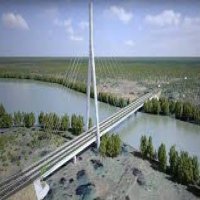On October 2, construction commenced on a 184-kilometer (equivalent to 114 miles) Kasomeno-Kasenga-Chalwe-Mwenda toll road, connecting Zambia and the Democratic Republic of Congo to established road infrastructures and harbors in Tanzania.
Zambia’s President Hakainde Hichilema and the President of the Democratic Republic of Congo, Felix Tshisekedi, jointly presided over the groundbreaking ceremony. This significant initiative is set to create a more efficient transportation link for the two nations, granting them improved access to the vital Tanzanian port of Dar es Salaam, which serves as their primary gateway to global markets.
The Kasomeno-Kasenga-Chalwe-Mwenda toll road project encompasses enhancements to certain portions of the current road, converting them into a two-lane thoroughfare, in addition to the construction of a new road segment. This new roadway also includes preparations for the construction of a single-pylon, cable-stayed bridge spanning 345 meters (1,131 feet) over the Luapula River, situated at the border between Zambia and the Democratic Republic of Congo.
The upcoming bridge is set to feature over 400 kilometers of cable strands. The project is being led by GED Africa, based in Mauritius, with support from Duna Aszfalt Zrt., the Hungarian construction branch of Duna Group. During the construction of the bridge, an estimated 8,000 cubic meters of excavation work will be executed.
Construction cost for the Kasomeno-Kasenga-Chalwe-Mwenda toll road
The road project is estimated to have a value exceeding $700 million. Upon its completion, the new road project will significantly diminish the travel distance for commercial truckers, reducing the route by 500 kilometers. This reduction benefits the transportation link between the cobalt-rich Haut-Katanga province in the Democratic Republic of Congo and the Tanzania
Currently, mineral exports such as cobalt, titanium, and copper from the Democratic Republic of Congo, as well as agricultural products from Zambia, are transported via trucks through the heavily congested Kasumbalesa border crossing. This border crossing is responsible for handling international traffic to and from seaports in Mozambique, Namibia, Tanzania, and South Africa, making it one of the busiest in sub-Saharan Africa and a significant bottleneck for international trade.
The upcoming roadway is designed to accommodate speeds of up to 100 kilometers per hour (equivalent to 62 miles per hour). Other aspects of the project involve the installation of a tolling system, which includes 12 high-speed weigh-in-motion devices. Additionally, one-stop border posts will be established on both the Zambian and DRC sides of the crossing, along with associated warehousing and parking facilities.
The inception of the road project dates back to 2012 when it originated as an unsolicited proposal from GED Africa Zambia Limited, an affiliate of GED Africa. In 2016, the company entered into a concessions agreement with Zambia, encompassing financing, design, construction, operation, and tolling of the road under a private-public partnership model.
Subsequently, in the last quarter of 2022, GED Africa, via its subsidiary GED Congo, signed a 25-year concession agreement with the government of the Democratic Republic of Congo. A few months later, Zambia renewed its six-year-old concession deal with the same company.
These agreements, involving DRC’s state agency for public works, Agence Congolaise des Grands Travaux (ACGT), and Zambia’s Road Development Agency, include a clause stipulating that at least 30% of the construction work must be undertaken by domestic contractors.
GED Africa’s CEO, Klaus Findt, noted that the Kasomeno-Mwenda toll road project is strategically positioned to boost local trade and unlock the region’s potential by providing improved access to international markets through East African ports.
Read also Zambia and DRC sign MOU to build Kasomeno ? Mwenda toll road and Luapula Bridge project

